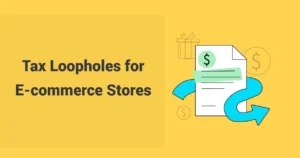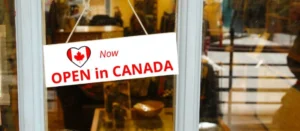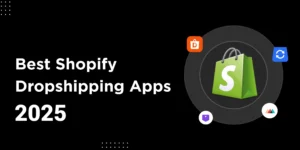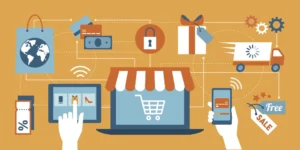We want to help you set up Shopify tax exemptions for B2B buyers, nonprofits, and wholesalers. Our goal is to make it easy and keep you compliant. You might be shocked to know that 68% of online sellers got hit with tax fines in 2024 for messing up exemptions. Mistakes like skipping certificate checks or botching Shopify settings can overcharge customers or spark IRS/CRA audits.
Our post today at SAL Accounting will break down how to nail tax exemptions on Shopify and reduce those costly errors. Stay with us in this comprehensive guide:
Quick Takeaways
- Tag tax-exempt customers correctly in Shopify to skip taxes legally and avoid errors.
- Always collect forms like IRS 501(c)(3) or CRA numbers before applying tax exemptions.
- Verify forms with IRS or CRA tools to prevent costly audit penalties.
- Use apps like Avalara to store tax-free forms securely and save time.
- Set zero-tax rates for exempt products or single orders in Shopify settings.
What Are Shopify Tax Exemptions?
Some Shopify customers don’t pay tax at checkout. That’s a Shopify tax exemption. You skip charging sales tax or GST/HST for certain buyers in the U.S. or Canada because of their special status, like nonprofits or resellers. Let’s break it down:
- Tax-Exempt: No tax at all. Think of a U.S. nonprofit with an IRS certificate.
- Zero-Rated (Canada): 0% GST/HST for stuff like exports. You still track it.
- Exemption Certificate: Proof, like a resale form, that says they don’t pay tax.
Mess this up, and it hurts. Overcharge a Canadian charity $390 on a $3,000 order, and they might shop elsewhere. Plus, mistakes can land you in trouble with the IRS or CRA audits. Check out our Shopify accounting services for expert support.

Who Qualifies for Tax Exempt Customers on Shopify?
Some customers don’t owe tax. Only specific buyers in the U.S. and Canada get to skip tax. Let’s break it down so you know who they are. Check the Shopify seller tax guide for U.S. and Canadian businesses for more.
U.S. Qualifications
You can skip tax for these U.S. buyers:
- Resellers: Stores buying your products to resell, like a shop getting your candles. They need a state tax form.
- Nonprofits: Charities or schools with an IRS tax-free certificate (IRS Free File).
- Government Buyers: Some federal or state groups with tax-free forms.
Example: A Texas bookstore buys $2,000 of notebooks. They show a state tax form. You skip $165 in sales tax, but keep that form.
Canada Qualifications
In Canada, these buyers skip GST/HST:
- Exporters: Businesses sending their goods abroad, like a wholesaler shipping clothes. They get zero tax.
- Nonprofits/Charities: Groups with a CRA tax number.
- Indigenous Buyers: Some First Nations with status cards.
Example: A Canadian exporter orders $5,000 of clothes overseas. Their CRA tax number lets you skip $650 in HST.
Here’s who qualifies for tax-exempt customers on Shopify:
| Buyer Type | Country | Required Form | Tax Skipped |
| Resellers | U.S. | State tax form (e.g., CDTFA-230) | State sales tax |
| Nonprofits | U.S. | IRS 501(c)(3) letter | State sales tax |
| Government Buyers | U.S. | Government exemption form | State sales tax |
| Exporters | Canada | CRA GST/HST number | GST/HST |
| Nonprofits/Charities | Canada | CRA GST/HST number | GST/HST |
| Indigenous Buyers | Canada | Indigenous status card | GST/HST |
How to Apply Tax Exemption on Shopify: Step-by-Step Guide
You can set up tax exemptions in Shopify easily. Here is how you skip tax for products, collections, or customers like nonprofits or resellers. Have a look at what every e-commerce business must know about the sales tax nexus, too. Follow these steps to do it right.
1. Log into Your Shopify Store
Open your Shopify store. Sign in with your email and password. This opens the main control area for your shop. You need admin rights to change tax settings. If you’re not the owner, ask for access.
Pro Tip: Save your Shopify login page (like yourstore.myshopify.com/admin) to get in fast.
2. Go to Tax Settings
Find Settings at the bottom left of your dashboard. Click it, then pick Taxes and duties. This area sets how taxes work for your sales. Look at your tax setup to make sure it’s right.
Pro Tip: Check that your store’s tax areas (like U.S. states or Canadian provinces) are correct first.
3. Find the Exemption Area
In Taxes and duties, click “Manage tax exemptions.” This opens the spot where you set tax-free rules. It’s an easy tool, but you need to know what to make tax-free.
4. Make Products or Groups Tax-Free
Make a product group if you want no tax on some products, like “No-Tax Items,” for things like Canadian exports. You may need to know about the differences between sales tax and use tax in the U.S. Go to Products, then Collections, and add those items. In tax settings, set the group’s tax to 0%.
Pro Tip: Use clear names like “NoTax-Exports-2025” to keep tax-free items separate.
5. Tag Tax-Free Customers
For customers like nonprofits, go to Customers in your dashboard. Pick a customer, click Edit, and add a “Tax-Free” tag. In tax settings, tie this tag to a 0% tax rate. Their orders skip tax.
Example: A US nonprofit buys $1,500 of school supplies. You tag them “Tax-Free” and keep their IRS form. This skips $120 in sales tax.
Pro Tip: Use tags like “Tax-Free-US” or “Tax-Free-CA” to sort customers by country.
6. Get Tax-Free Proof
Always get a tax-free form, like an IRS paper for U.S. nonprofits or a CRA number for Canadian exporters. Ask customers to email it or use an app like TaxImmune. Save it for audits. No form means trouble. Our e-commerce accountant in Toronto can provide expert help in this regard.
Pro Tip: Use an app like Avalara to collect and save forms without mistakes.
7. Shopify No Tax Setup for One Order
If you need to skip tax for just one order, go to Orders, then Draft Orders. Make the order, set tax to 0%, and write why, like “Nonprofit Form #123.” Keep the form in customer notes or a safe spot.
Here’s a quick guide to set up tax exemptions fast:
| Step | Action | Pro Tip | Tool/Setting |
| Log into Store | Sign in to Shopify dashboard | Save login URL for fast access | Admin dashboard |
| Go to Tax Settings | Click Settings > Taxes and duties | Verify tax regions first | Taxes and duties |
| Find Exemption Area | Click “Manage tax exemptions” | Know what to exempt | Exemption settings |
| Products/Groups Tax-Free | Create collection, set 0% rate | Name like “NoTax-Exports-2025” | Products > Collections |
| Tag Tax-Free Customers | Add “Tax-Free” tag to customer | Use “Tax-Free-US/CA” for sorting | Customers > Edit |
| Get Tax-Free Proof | Collect IRS/CRA form for audits | Use Avalara for easy storage | Customer notes/app |
| No Tax for One Order | Draft Orders, set 0% tax | Note reason and store form | Orders > Draft Orders |
Requirements for Exempt Sales on Shopify + Forms
You need forms to skip tax legally. Without them, you could get fined or lose customers. Here are the forms buyers must give you for tax-free sales.
- Resale Certificate: U.S. resellers, like stores, use this state form (like California’s) to buy tax-free for resale.
- IRS 501(c)(3) Letter: U.S. nonprofits, like charities, show IRS 501(c)(3) Letter to skip sales tax.
- Government Exemption Form: U.S. government buyers use the government exemption form to avoid state tax.
- GST/HST Number: Canadian exporters or nonprofits use this CRA number for no tax. GST/HST returns in Canada are essential for Shopify sellers.
- Indigenous Status Card: Canadian First Nations buyers show this to skip tax.
- Read More: “How to File Form 1099-K for E-commerce: Amazon, Etsy, eBay, Shopify, and More”
Keeping Tax Exemptions Compliant on Shopify
You’ve set up tax exemptions. Now, stay legal. Handling tax-free forms like IRS certificates or CRA numbers keeps you safe from fines. Here’s how to manage them right.
1. Collect Tax-Free Forms
Get proof before skipping tax. U.S. nonprofits need an IRS tax-free form. Canadian exporters need a CRA tax number. No proof, no tax break.
2. Check the Forms
Make sure forms are real. For U.S. buyers, confirm IRS or state forms are current. Some expire yearly. For Canadians, use CRA’s online tool to check GST/HST numbers. This avoids audit trouble.
Example: A US nonprofit buys $10,000 of supplies. Their IRS form is valid, skipping $800 in tax. You’re safe if audited.
3. Store Forms Safely
Keep forms for 3-7 years. Save them in Shopify’s customer notes or a folder. Apps like Avalara work too. You’ll need forms ready for IRS or CRA audits.
Pro Tip: Use the best e-commerce accounting software in 2025. An app like Avalara helps you save forms and avoid email mess.

Case Study 1: Avoiding a U.S. Audit for a B2B Shopify Seller*
A California Shopify seller contacts SAL Accounting:
Problem: They sell $50,000 yearly to a reseller. They tag them “Tax-Free” but don’t check or save the state tax form. A state audit risks a $4,000 fine. Poor records worsen it.
What We Do: We verify the Resale Certificate (CDTFA-230). We use Avalara to store forms. We tag “Tax-Free-US” in Shopify. We save forms in a cloud folder.
The Result: The seller skips the $4,000 fine. They save $4,125 in taxes on $50,000. Exempt sales run smoothly, and audits are no worry.
*Hypothetical scenario
Smart Ways to Master Shopify No Tax Setup in 2025
You’re handling tax exemptions like a champ. Still, these ideas help you save time and stay legal with Shopify B2B tax exemptions.
- Use Apps for Forms: Apps like Avalara or TaxImmune grab and store tax-free forms. This cuts down manual work.
- Name Tags Clearly: Use tags like “Tax-Free-US” or “Zero-Tax-CA.” It keeps your customers organized.
- Watch 2025 Tax Changes: U.S. states made 408 rate changes in 2025.
- Train Your Team: Show staff how to spot real tax-free forms. It avoids mistakes with nonprofits or resellers.
- Back Up Forms: Save forms in a cloud folder or app. You’ll need them for IRS or CRA audits. Connect with the SAL Accounting team for Shopify accounting services today.

Case Study 2: Saving a Canadian Nonprofit with GST/HST Exemptions*
A Toronto Shopify store contacts SAL Accounting:
Problem: They sell $30,000 in fundraising gear. They overcharged $3,900 in HST. The nonprofit’s CRA tax number isn’t tagged right. Donors complain, audit looms.
What We Do: We verify the GST/HST Number with CRA’s tool. We tag “Zero-Tax-CA” in Shopify. We set a “No-Tax Items” collection. We refund $3,900.
The Result: The nonprofit skips $3,900 in HST. Donors stay happy. The store avoids audits; exemptions are automatic.
*Hypothetical scenario
Final Thoughts
Shopify tax exemptions help you save money and keep customers happy. You can avoid mistakes by handling exemptions for B2B buyers, nonprofits, and wholesalers correctly. This guide shows you simple steps to set up tax exemptions, check forms, and manage your Shopify store’s taxes in 2025.
If you need help with Shopify taxes or accounting, contact us at SAL Accounting to make compliance easy and boost your savings.
FAQs on Shopify Tax Exemptions
Go to Customers, pick a customer, and click Edit. Add a “Tax-Free” tag. In Settings > Taxes and duties, link the tag to a 0% tax rate. Get their tax-free form, like an IRS certificate, to stay legal. This skips tax on their orders.
Yes, nonprofits can skip taxes. They need an IRS 501(c)(3) form (U.S.) or CRA tax number (Canada). Verify the form and tag them “Tax-Free” in Shopify. Save the form for audits to avoid fines.
Yes, always collect tax-free forms. Resellers, nonprofits, or exporters must provide proof, like a state tax form or CRA number. Without it, you can’t skip tax legally. Keep forms for 3-7 years.
Yes, you can skip tax for one order. Go to Orders > Draft Orders, create the order, and set tax to 0%. Note the reason, like “Nonprofit Form #123.” Save the form for records.
Yes, some Canadian customers skip GST/HST. Exporters, nonprofits with CRA tax numbers, or Indigenous buyers with status cards qualify. Verify their number and set a zero-tax rate in Shopify.






